At last we have a reprieve from the heat and humidity with temperatures almost 10°C lower than what we were experiencing during the week.
The cooler temperatures and comments on previous postings (thanks Janet) have inspired me to bake some wholemeal loaves.
Before I started home milling one of my favourite wholemeal flours was from a biodynamic mill in South Australia (Four Leaf Milling). Though the flour was not strong it had exceptional flavour and a golden hue with large soft pieces of bran. Being biodynamic was a bonus despite the carbon footprint getting it to Brisbane … sigh.
I now purchase grains from Four Leaf to mill. The flour I mill is in no way comparable to the flour produced by Four Leafs stone mill. The Komo mills the grain evenly and I am not getting the variation in bran size … I am however getting the lovely golden colour and sweet aromas.
The house bread this week was to be something sweet or fruity. I settled upon golden raisin and fennel bread with some inspiration from “Tartine Bread” but with some toasted pine-nuts added.
I have been using the Four Leaf grains in conjunction with stronger wheat from Kialla Pure Foods at usually a 50/50 mix but for this bread I used solely Four Leaf grains.
Levain


The levain was built using AP flour with 10% fresh milled grains. At the same time I autolysed the flour in cold water from the fridge allowing it to come to room temperature before final mixing. Six hours later the levain was light and tasted fruity with only a small note of tang and the autolyse dough was sitting at room temperature … perfect.
I kept this in mind ... knead lightly, it won’t take a lot of punishment. Patience when adding mix-ins. Stretch and fold carefully. Shape gently. Watch for signs of tearing. Top with sesame seeds.
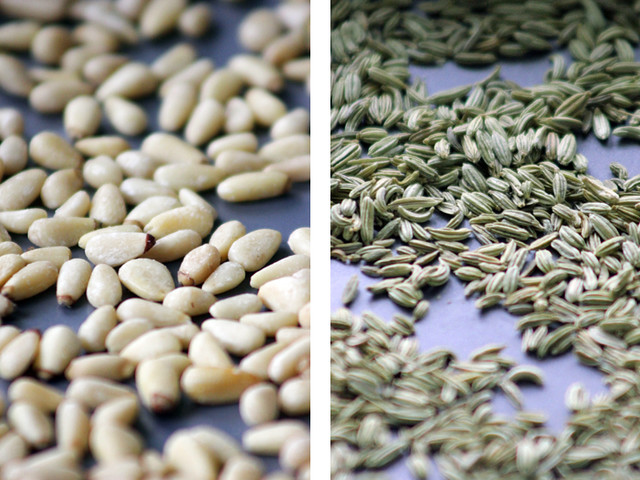

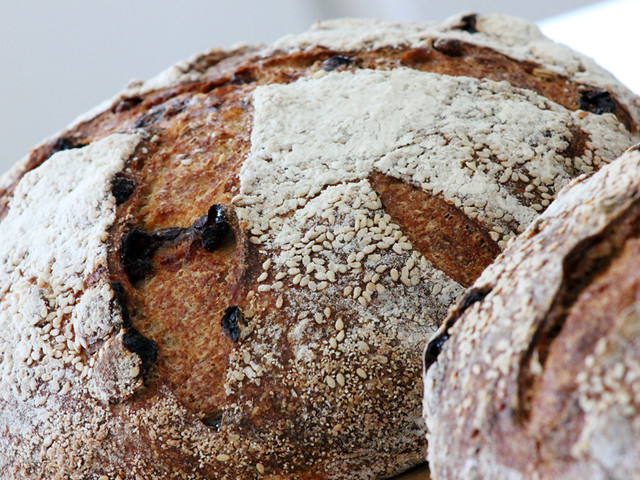
Wholemeal Golden Raisin and Fennel au Levain
Formula
Overview | Weight | % |
Total dough weight (minus mix-ins) | 2000g | |
Total flour | 1081g | 100% |
Total water | 919g | 85% |
Total salt | 20g | 2% |
Prefermented flour | 270g | 25% |
Desired dough temperature 24°C | | |
| | |
Final dough | | |
Levain @ 50% hydration | 405g | 50% |
Freshly milled wheat flour (Four Leaf grains) | 811g | 100% |
Water | 784g | 96% |
Salt | 20g | 2% |
Mix-ins | | |
Raisins | 375g | 46% |
Pine-nuts | 70g | 9% |
Fennel Seeds | 20g | 2% |
Rind from one orange | | |
Method
- Autolyse flour and water from fridge for six hours. (hold back 50 grams of water)
- Soak raisins for 30 min in water then drain. Toast fennel seeds and pine-nuts in oven until lightly browned.
- Add levain to autolyse then knead (French fold) 5 mins. Return the dough to a bowl and add salt and 50 grams of water and squeeze through bread to incorporate (dough will separate then come back together smoothly), then knead a further 10 mins.
- Gently mix in raisins, pine-nuts, fennel seeds and rind until combined.
- Bulk ferment two hours with two stretch and folds in the first hour 30 mins apart.
- Preshape. Bench rest 20 mins. Shape.
- Final proof was roughly one hour at room temperature (25°).
- Bake in dutch oven for 10 mins at 250°C then 10 mins at 200°C. Remove loaf from dutch oven and bake a further 20 mins at 200°C.
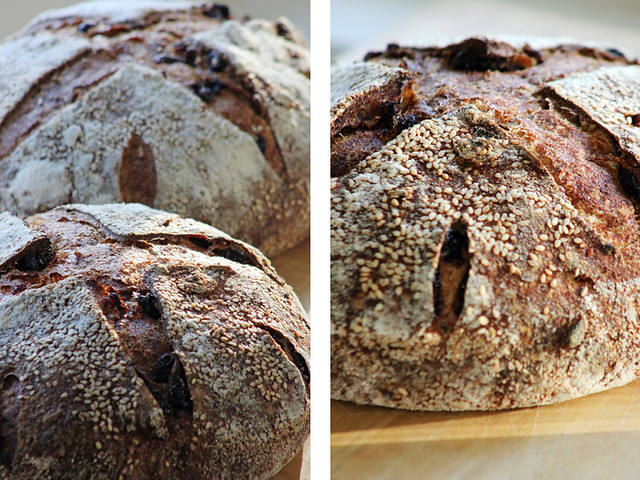
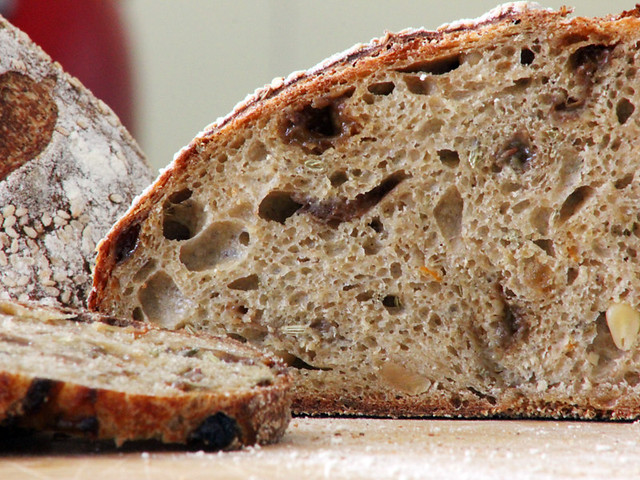

Today I had two more bakes lined up. I hoped to continue the success of the “Anygrain Sourdough” from last weeks post with an 80% Rye Sourdough. I have pieced together this formula from advice and nuggets of information gained on the TFL. (Thanks Mini Oven, nicodvb and Andy)
I am still noticing my fresh milled rye has a tendency to ferment very quickly. I took advantage of the cooler conditions and experimented. Firstly I cooled the grains in the fridge before milling. Secondly I milled the grains carefully. I used a coarser setting than before for the starter build and a very coarse setting for the soaker and made full use of sifting for the flour required in the final dough (which meant I did not need to mill this finely either).

After milling I allowed the flour to come to room temperature before mixing the starter using a very small seed amount. I also mixed salt in the soaker to control any enzyme activity that might take place overnight. I designed the formula to allow me to autolyse the sifted wheat flour with the remaining water. I am not looking to increase the temperature of the final dough by controlling water temperatures (I wonder if this is where I have come unstuck in the past by increasing the dough temperatures and thus speeding the fermentation)

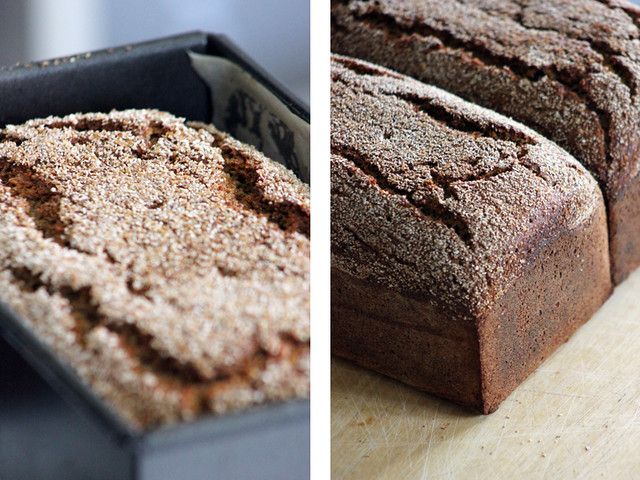
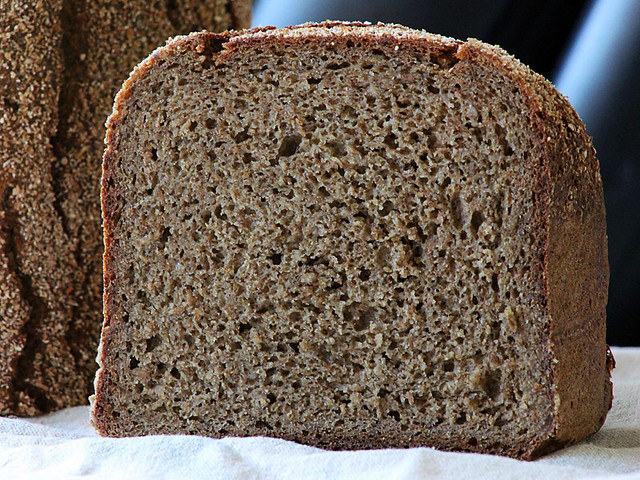
80% Rye Sourdough
Formula
Overview | Weight | % |
Total dough weight | 2600g | |
Total flour | 1351g | 100% |
Total water | 1149g | 85% |
Total salt | 24g | 1.7% |
Prefermented flour | 472g | 35% |
Desired dough temperature 25°C | | |
| | |
Starter build – 18 hrs 24°C | | |
Starter (Not used in final dough) | 25g | 5% |
Fresh milled rye flour | 472g | 100% |
Water | 591g | 125% |
| | |
Soaker– 12 hrs 24°C | | |
Coarsely milled rye | 288g | 100% |
Altus (100% rye sourdough) | 100g | 34% |
Water | 288g | 100% |
Salt | 24g | 1.7% of total flour |
| | |
Final dough 25°C | | |
Starter | 1063g | 180% |
Soaker | 600g | 101% |
Fresh milled rye flour sifted | 321g | 54% |
Fresh milled wheat flour sifted | 270g | 46% |
Water | 270g | 46% |
Method
- Day before prepare rye starter then soaker.
- Next day autolyse sifted wheat flour and water for one hour, then stir with spoon for 5 minutes.
- Add the rest of the ingredients and mix until combined.
- Shape and place into greased tins (mine were 8 x 4 x 4 Pullman) seam side down.
- I proved these for one hour and 15 mins before docking and placing into oven with lids on for 15 minutes at 270°C then a further hour at 210°C
This has been my most successful high percentage rye bake yet. Even after one day the flavour really is really something with softened coarse rye doted throughout the crumb. Sour, strong and clean, I think because the crust is not harsh or too dark ... easy to cut. Another day and it will slice perfectly.
Last but not least was a batch of Three Grain Country Sourdough for Nats parents and our loyal customer (thanks Neeks .. hope you like this one)
This was the most interesting bake of the three. Yesterday I purchased a small amount of really nice looking wheat grains from Wholegrain Milling Company and I decided I would use them in the Three Grain Country bread. The milling revealed a golden coloured flour and a soft brown bran that was sifted out. The autolysed dough seemed dryer at first and I initially thought I may have to increase the hydration but after kneading and adding salt the dough came together nicely. (Sifted fresh milled flour is foul to knead until salt is added … S T I C K Y)

This is where things deviated … During the bulk ferment I noticed the dough was a lot more extensible than previous doughs and did not hold its shape quite as well. The preshaped rounds plumped up nicely and again where very extensible during shaping … It was the final proof that almost caught me unawares. They proved in 30 minutes. When I checked the dough in passing I almost had heart failure when a poke indent hardly rose. Panic stations as I prepared the peel and steaming setup, the whole time debating in my head if the dough could really be ready … nothing like self doubt … Just kept telling myself to listen to what the dough was telling me. The dough sprang into life in the screaming hot oven much to my relief.
I am wondering about these grains and whether I damaged the starch excessively when milling as they certainly behaved differently. I may use a 50/50 mix with the Kialla grains next bake. No crumb shot of these but they feel soft and springy to the touch.
The stand out bread of these bakes is the Wholemeal Golden Raisin and Fennel. We had it this morning untoasted for breakfast with honey and ricotta and it has the texture of soft golden cake. It is not chewy. It is not sour. A slice of it is sweet and moist with strands of orange rind sparkling in the crumb. It was hard to stop finding reasons to cut another slice.
Looking forward to breakfast tomorrow ...
All the best,
Phil